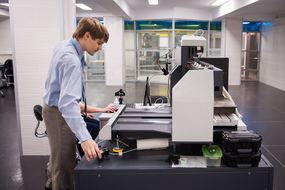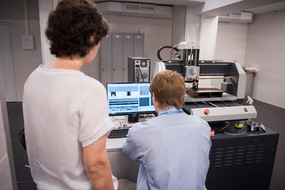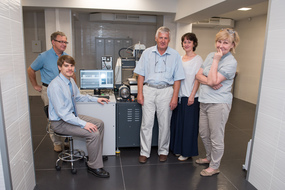A group of NUST MISIS scientists led by Professor Alexsander Karabutov have developed a unique domestic laser-ultrasonic device which is capable of detecting defects inside aircraft materials with an accuracy of a hundredth of a millimeter. The application of the development in the production and operation of aerotechnics will take the field’s qualitative characteristics and reliability to a never before seen level.
Development of the technology is connected with mechanical and thermal loads on the most critical components of construction, and requires the use of new strategic materials as composites and additive surfaces. These materials are unique in strength and lightness but are structurally heterogeneous, resulting in a critical destruction happening faster than in traditional metals.
Micropores, or defects in the components of aircraft mechanisms, may form into cracks under the influence of the aggregate AC voltage in the air, possibly leading to a crash if the crack becomes big enough. To avoid these disasters, aircrafts must undergo three-dimensional examination of their inner structure, which will detect defect centers at a very early stage.
“A group of scientists from a new NUST MISIS laboratory, led by Doctor of Physical and Mathematical Sciences Professor Alexsander Karabutov, and launched in 2015 through Project
5-100, has presented the new technology of laser-ultrasonic structural analysis containing the unique possibility of creating 3D control of materials, components, and aerospace products”, said Alevtina Chernikova, Rector of NUST MISIS.
The laser-ultrasonic structuroscopy developed at NUST MISIS has a high space resolution (50 microns) while maintaining a depth of vertical profiling (up to 40 mm), which allows engineers to characterize defects according to their mechanical characteristics and forms. Essentially, the structuroscopy forms a 3D model of an aircraft part, making it easier than ever to diagnose safety concerns.
According to Professor Alexsander Karabutov, head of the project, “in contrast to the traditional ultrasound, in laser-ultrasonic structuroscopy a laser is used to generate sound pulses, and for the registration of the corresponding echo signals ultrabroadband piezoelectric hydrophones are used. This allows the enhancement of the space resolution of the ultrasonic control by
6-10 times, and obtains numeric information about the state of the materials — elastic modulus, porosity, stress conditions, and distinguishing hard and soft nonuniformity. Measurements can be automated, which increases the reliability of control”.
The ultrasonic beam, generated by a laser impulse, has many unique characteristics which are almost impossible to implement by traditional means — ultrashort pulses, maintenance of clear pulse shape, and a narrow ultrasonic beam without side interference. These features allow the user to control parts in such conditions when other methods are ineffective—for example detecting and distinguishing exfoliation between each successive layer of composite material.
The prototype of an automated NDT system has been successfully tested to control the carbon fiber torsion box in the wings of the new Russian short and medium-haul passenger airliners, including load tests.
The initial batch of the innovative laser-ultrasonic fault detectors have already been launched in limited production, and are soon planned for use in the domestic aerospace industry.
Professor Alexsander Karabutov is the head of NUST MISIS Laser Ultrasonic Nondestructive Testing Laboratory, winner of the NUST MISIS open international grant competition. Areas of expertise: powerful acoustic beams, self-action of discontinuous waves, self focusing of ultrasonic beams, laser optoacoustics, laser & ultrasonic spectroscopy and tomography.






